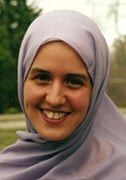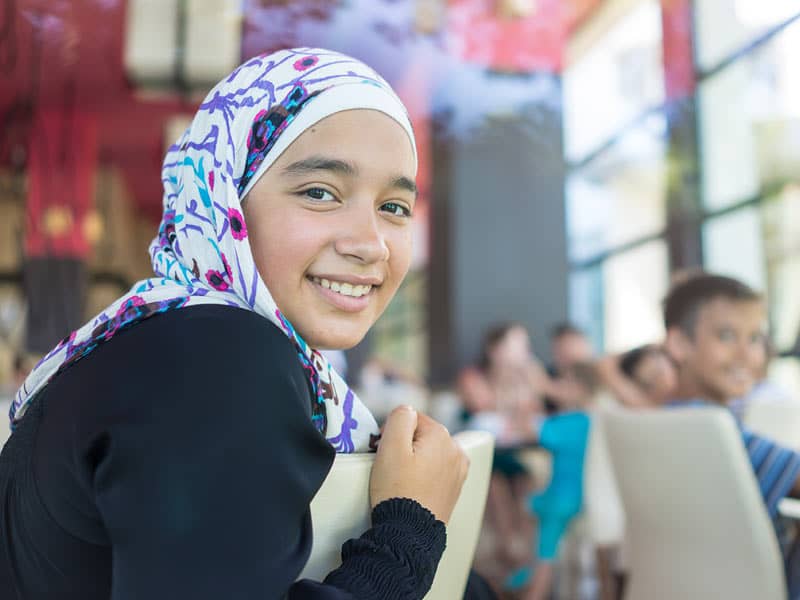 Taking off my hijab didn’t just happened in one dramatic instant. Yes, there was a moment in a crowded bathroom at the Abu Dhabi airport, in the United Arab Emirates, when I unwound the gauzy blue scarf from around my head and stepped back out into a mixed-gender world, feeling naked.
Taking off my hijab didn’t just happened in one dramatic instant. Yes, there was a moment in a crowded bathroom at the Abu Dhabi airport, in the United Arab Emirates, when I unwound the gauzy blue scarf from around my head and stepped back out into a mixed-gender world, feeling naked. But really, taking off the hijab was a year-long process of stripping me down and peeling back the assumptions and beliefs I had wrapped tightly around myself as a recent convert to Islam. It was like I had fallen in love with Islam, married it, and then discovered a whole bunch of things that were difficult, if not impossible, for me to live with on a day-to-day basis. I wanted the relationship to work; I started looking for compromises.
That process was lonely, and difficult, but I stepped out of that bathroom--and that year of endless reflection--as a new kind of Muslim, one, I hoped, I could comfortably live with for the rest of my life. That’s the kind of Muslim I still aspire to be today: True to the religion’s most basic principles and practices, but questioning of dogma and traditional interpretations. Back when I wrestled with these ideas, I realized that I needed some religious breathing room. And I had to take off my scarf to find it.
 My de-jab (taking off the hijab) story begins with how I came to Islam and started to wear a headscarf. I didn’t start wearing hijab right when I converted in 1999. Indeed, when I first said my shahadah, or testimony of faith, in the house of Scotch-Indian-Zimbabwean friends in Harare, I had given little thought to how I would dress as a Muslim. Not long after my conversion, for example, I bought a two-piece purple bathing suit and wore it on the beach in Tel Aviv, Israel without a second thought.
My de-jab (taking off the hijab) story begins with how I came to Islam and started to wear a headscarf. I didn’t start wearing hijab right when I converted in 1999. Indeed, when I first said my shahadah, or testimony of faith, in the house of Scotch-Indian-Zimbabwean friends in Harare, I had given little thought to how I would dress as a Muslim. Not long after my conversion, for example, I bought a two-piece purple bathing suit and wore it on the beach in Tel Aviv, Israel without a second thought. As a journalist based in East Africa for several years, I had of course seen many Muslim women wearing many different kinds of coverings. All of them fascinated me, but none seemed to apply to me. In Mombasa, Kenya, for example, I watched a wrinkled Swahili Muslim woman balance her head-load of onions with one hand, carry a bucket of water with the other and clutch the black polyester folds of her robe between her teeth. I wondered at the time how a religious covering could so spectacularly impractical.
It was only when I returned to the U.S. from East Africa and saw educated Muslim American women my age wearing headscarves that I began to wonder why my own head was bare. Being a graduate student in theology, I tackled the question intellectually: Was covering my head and concealing the rest of my body an inviolable part of the religion I had embraced?
I asked this question to the de facto Muslim chaplain at Harvard, whose own wife wore full-length black robes and a face veil at the time. He pointed out that all four traditional schools of Sunni law agree that a woman should cover everything except her hands, feet and face as an act of modesty. That scholarly consensus seemed pretty persuasive. What I loved about Islam is that its essential wisdom--the necessity of daily prayer, the unity of God’s existence--seemed to transcend time, place and culture. Maybe this was true with veiling as well?
I prayed about it, I read about, and I talked obsessively about it with Muslim friends. Finally, the answer seemed clear: God wanted me to cover. I remember standing in front of my small mirror in Cambridge, Mass., feeling as if an angel were draping the folds of cloth over my hair. It required courage, of course, to walk out the front door that day. But fellow Muslims cheered me on, and I suddenly found myself invited to give talks and presentations at my local mosque.
But this positive attention also had a negative side. After 9/11 in particular, I began to feel like a poster girl for Islam, pushed out on stage in my prim headscarf to defend Islam in accent-free, graduate-schooled American English. A very conservative Muslim man I knew praised me at the time for "flying the flag of faith," and wherever I went, the symbolism of the scarf seemed to proceed me. I realized flags make uncomfortable clothing.
But the minor misgivings in Boston were nothing compared to the massive tremors of doubt I felt soon after I moved to Muscat, Oman, in 2002, with my husband (a fellow convert) and our baby son. It was hot--soul-crushingly hot--there I was, wrapped up like a skier ready to hit the slopes. As a stressed new mother, I felt like paying attention to stray strands of hair was absurdly trivial. And although I had a number of wonderful Omani friends, including educated, hijab-wearing, working women, I felt disturbed by aspects of the country’s sex-segregated, hijab-observing social order.
Once the handle had been turned, the questions began to drip incessantly through my head. Did I really want to wear the scarf? What had really motivated me to wear it in the first place? Was that enough to keep me wearing it? What would happen if I took it off? And the granddaddy of them all: Was wearing a headscarf truly required for all Muslim women?
That last question troubled me the most. I went back to the answer that had first convinced me, the idea that four Muslim schools of thought agreed a woman had to veil. I thought more about these men, these medieval scholars who had decreed covering from head to toe mandatory for women. I slowly realized: I did not convert to follow their lead; I had little if any allegiance to them. They were just people--yes, educated pious ones--but people who lived at a particular time and place. I had embraced Islam as recognition of God’s oneness. And deep down I felt that infinite oneness was big enough to allow me to be myself and remain within it at the same time.
I knew many other Muslims pointed to certain verses in the Qur’an as "proof" that a certain type of covering was required. But study them as I might, I always found those verses ambiguous. One of the most crucial, Chapter 24, verse 31, reads in my English translation, in part: "And say to the believing women that they should lower their gaze and guard their modesty; that they should not display their beauty and ornaments except what (must ordinarily) appear thereof; that they should draw their veils over their bosoms and not display their beauty…" What exactly was that supposed to mean? It presented me only with more questions and the conviction that each believer must ultimately make some decisions on her own, however lonely that may be.
The turning point for me came one evening at a Muscat shopping mall when an obviously gay young man strode through the food court to order some fried chicken. I nearly gasped when I saw him. I had seen gay people before, of course. But in Oman, where gender is literally designated in black and white, the site was shocking, and I saw others around me gape and even laugh at him. Then I heard a voice inside my head say, "That’s brave."
At that moment, I saw how religious opinions become rules, and how rules become cultural norms, and how norms can extinguish the bright light of individual truth. I wanted to applaud that man, or hug him, or do sometime except sit there with a scarf on my head, inadvertently supporting a strict and--I realized right then--restrictive gender system in which he had no place.
I am uncomfortable with aspects of the Qur’an and classical Islamic law that allow polygamy, or unilateral male divorce, or make a women’s legal testimony worth less than a man’s. In my mind, now, the scarf is of one cloth with those ideas, and I needed to separate myself, at least symbolically, from them. Some of these principles are deeply embedded in Islamic law and scripture, so I don’t have any easy answers about how to reconcile those issues with my belief in God’s oneness and the simplicity and efficacy of the system of worship revealed to the Prophet Muhammad. And there are moments when I see a woman clad in her beautiful scarf and feel as if I have lost something.
But this long process was a one-way street, leading me to that bathroom in the Abu Dhabi airport, where I paused for a moment in the front of the mirror, surrounded by scarf-wearing, young Indonesian girls on their way to jobs in the Persian Gulf. I knew when I walked back upstairs the strange men in the waiting area would stare at me, but like that first morning when I first draped the scarf over my head, I just had to get on with it.
Back in the U.S., I was afraid to show myself to Muslim friends who knew me as a hijabi. Yet every one of them was kind and welcoming, and if they questioned my decision, they didn’t let me know. Sometimes at the mosque now, I see newly minted converts wearing headscarves and floor-length robes, or abayas, and I have the urge to whisper to them, "You can still be yourself"--but I don’t. I know each woman has her own path, her own story, and, perhaps, her own lessons to learn. Ultimately, I have come to feel, hijab is a question of religious freedom. I support the right of women both in the U.S. and abroad to dress in accordance with their beliefs – and I hope they can support my decision to do the same.

